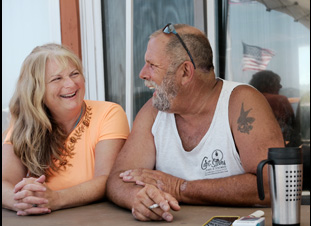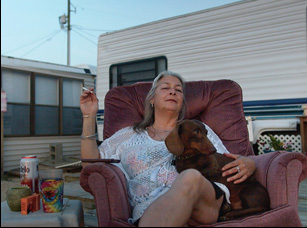“To do this every day is something,” says one of the residents of Inlet View, a campground on Chincoteague Island on the coast of Virginia looking out over the sun dipping into the sea at dusk in “Happy Campers.” You can’t argue with the natural beauty on display, but other residents joke that the waterfront property is “the armpit of America,” a place where the view would typically attract multi-million dollar estates, but here is home to much cozier domiciles as people tuck into tightly-packed trailers. There may not be fancy accommodations, but there is an unusual level of contentment anywhere you look as denizens have made their parcel of land their own with ornate decorations outside and inside people play cards or entertain themselves with their Roomba.
The place was so irresistible to the filmmaker Amy Nicholson that she booked a summer rental and found herself sticking around for what would turn out to be the campground’s final days as a developer laid claim to the real estate, putting its most valuable asset — the community — in jeopardy. However, true to its title, “Happy Campers” resists wallowing in the impending destruction of the area that meant so much to so many over generations, but rather to capture the happiness that exists there while it lasts and create something that’ll endure. Gently moving between one home to another and settling into at least a few BBQs and games of horseshoe along the way, Nicholson conjures that same feeling of summer that she experienced first-hand as residents rejoice in their surroundings, living like kings as they eat the crabs that crawl up from the shore and enjoy one another’s company far from the hustle and bustle.
“Happy Campers” is rife with the simply pleasures and has been spreading joy since it premiered last fall at DOC NYC and criss-crossed the country on the festival circuit. Now putting down stakes in New York this week en route to touring the U.S. theaters once more for its proper release, Nicholson spoke about reflecting the warmth that she felt living in Inlet View, having to be a one-person crew to retain the intimacy that the community cherished, and finding a structure for the film that defied a narrative as the place itself did.
I grew up in Baltimore, home of John Waters, and Chincoteague Island is just one of those places you go as a kid. It’s a family vacation spot [where] people make their living off the water fishing and crabbing. It’s very quiet and I just knew about it [even though] my parents did not stay in the family campgrounds. We did a lot of day trips there, but they never stayed. But I was down there taking pictures in the dead of winter [one year] and I wandered into this place because it was closed, but they didn’t really have a gate up and I was fascinated by the amount of houses there. At first, you would think like, what’s going on in here? But once you got in there, it was amazing. The campers were like 10 feet apart, but they had all been customized. Somebody would add a porch or put a mermaid on the front. People had flower beds and tiki bars and my [future] neighbor, Mary had a big peace sign on her camper. It was just amazing and I fell in love with it. I took a bunch of pictures and forgot all about it. About 10 years later, I was driving around with my dad down there and I said, “Go into that campground. There’s something about that place that I just love.” It was summer and with the people there, it was so great.
Knowing this sort of started out with still photography, did that muscle memory come back as far as how you wanted to capture this?
I didn’t really know how to shoot [a film as a director of photography would], and [I’ve worked with] Jerry Risius, a beautiful cameraman who shot like every great documentary and learned from Bob Richman, who I’ve also worked with, but there was no taking a crew in there, so I thought I’m just going to have to learn to use a camera. I leaned a little bit on my still camera skills, but it’s a lot to do sound and movement [at the same time] and also just to interact with people because these were my friends and my neighbors and you couldn’t go under headphones and ignore the people. So I just did [the camerawork] in a way that I felt like I would get the closest to a face-to-face [with] two people talking like I was always there hanging around.
I wanted the film to feel that way [where] you get to do what I did all summer, which is to just wander around. I had a little garden cart with all my stuff in it and when I saw someone I wanted to talk to, I would just stop and talk to them, or I would say, “Oh, can I film that?” Like the little boy with the dog, I just came across he and his grandma making dinner and I said, “I haven’t seen you guys yet this summer,” and [the grandma] said, “Yeah, we’ve been meaning to get here,” so I asked “Can I film you making dinner?” Then Ethan the little boy said, “Do you want to see inside my grounds?” And I said, “Why yes, of course I do,” and he gave a tour like he could be at Buckingham Palace. He’s so excited. Things like that were [where] I got really lucky.

John Young and Laura Israel, who edited this film, would be very happy to tell you that was something we had to decide early on because when you’re dealing with time of day, we decided before we even had any other kind of structure that we would build it from morning to night because it was just easier to follow the rhythm of the people and what happened there. If you skipped around, it was really distracting. You couldn’t go from dark skies and fireworks or campfires to morning and people having coffee. So we built the structure on top of that and it really helped us organize the footage because you just put everything in buckets. I had these big books of still frames of every shot that I took and they were organized in terms of evening and then sub-organized in terms of activity.
There are a couple of really beautiful montage sequences built around some of the residents’ art — the man playing the guitar and a woman who recites her poetry. Were those fun sequences to work on?
They were, and because I was shooting by myself John said to me [during the edit], “You didn’t shoot any scenes.” I had shot a couple — I I had fireworks, I had a dinner. But they were really more montage than the classic scene [format] with coverage. It was a little easier to get coverage when when people were starting to pack up because there was a time frame and there was activity that was specific. When people were just sitting around on a dock, you can only cover it so many ways. It helped us to have things like the poem and the card game, just so you had a chance to stay in one place for a little while. The meandering [around the property] is wonderful, but every now and then, you need to stop and just soak in one thing. [And those scenes] were used for different reasons. The poem is there strictly to expose how grateful these people were to have any time there at all and that poem sums it up for me. It was a funny little poem read [aloud] by Rita, written by her husband about her, but it really applied to the whole situation.

Yes, but it really happened when we got to a fine cut because we knew we didn’t want a traditional structure because it wasn’t a traditional story. It’s like a piece of time that you need to experience. And we had great people giving us feedback [on cuts of the film], but it’s very difficult when you’re getting feedback because people will push you to say, “Well, you need to let people know what’s going on [instead of something more impressionistic]” and we tried everything. There was a lot more to the fact that people got notice from the developers that the property was in play. There was a letter [sent to residents] and it was a pretty dramatic time and we made it very dramatic.
But then what happened in our rough cut screening, which we did at DCTV with the International Documentary Association, is there were a lot of filmmakers there [in the audience] and they said, “Well, I feel like I’m waiting for the film to show me their fight, and that they were going to fight this [for the whole film],” so it led people in the wrong direction. Then we got Isidore Bethel as a supervising editor who was wonderful, and said, “Well, how did it really happen?” And I said, “It just kind of happened. Every now and then people would mention something, but they knew the writing was on the wall. So they were resigned [to it].” And he said, “Then build it that way and take a lot of stuff out so we can spend time with those people.” And we did. It really fixed the film and that was the biggest change structurally in how we put it together.

Of course, and also to give it to the rest of the world because the experience I had was life changing. That sounds so big and important, but I never was happier. I had nothing [on me] — a pair of flip flops, a camera and a garden cart, and my husband would come down and he would play horseshoes with the guys all day while I was shooting or hanging out with the girls. There was a whole group of women down at our end that were really fun. So I would love if people watch the film and walk away thinking, “Maybe I don’t need all that. Maybe just some good friends is good enough.” I hope I can give that back and also preserve the memory of those fabulous people that were there and also make heroes of them. They were really just salt of the earth, one of the best groups I’ve ever met, and it’s my homage to them.
“Happy Campers” opens in New York on August 7th at the IFC Center and Los Angeles at the Monica Film Center on August 21st and at the NoHo 7 on August 22nd.





